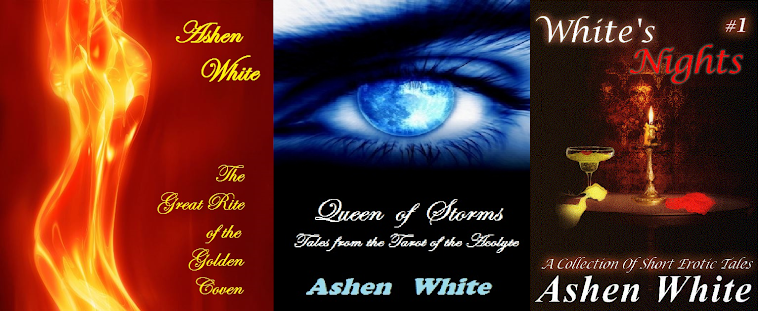This one is dedicated to Tiffany Reisz (@tiffanyreisz) for the happy tweets and chats. Good luck with the novel, honey, and, if you need any help - you know where to grab me! ;-)
Take care, y'all, until next time!
Ashen
* * * * *
It's always a constant pleasure to me to see how many ways the female of our species is used (and frequently abused) in the artwork that makes up so many Tarot decks. It's natural, of course, to recognise the beauty of our female form in so many homages, and it does appear with significant strength in many of the symbolic characters in Tarot - The Priestess, Strength, The Star, Justice, The World, etc - but the real challenge of the artist is to come up with a new, fresh visual interpretation that can portray to the reader an underlying message that can, subsequently, be used to invest and interpret a spread for a querant.
Regular visitors to my blog will be well aware of my love and fascination for the 10 of Swords from the Fenestra Tarot (see below), which is one of those powerful abuses that is visually and emotionally appealing, whether you are invested in the meaning of the card or not. Recently, I encountered the 8 of Swords from the Legacy of the Divine Tarot, and the striking resemblance to the Fenestra 10 of Swords struck me so much, it inspired me to write this blog entry.
The Legacy of the Divine card shows the lissome female form, barely clothed in a flimsy wrap, suspended in the giant web of some unseen creature, while the 8 swords of the card race from various angles to pierce her waiting, ensnared flesh. Fortunately for her, she is blindfolded by the wrap, and thus not aware of the fate that is rapidly approaching her.
The 8 of Swords is known in Tarot as the Card of the Captive, and, to some, is meant to portray the beautiful Andromeda, chained to the rock, an offering to the sea-monster Cetus, as a punishment for her mother, Cassiopeia, bragging about her own beauty. A case of the Sins of the Mother, if ever there was one!
The 8 of Swords symbolizes a crisis in the life of the Querant, although not a crisis that is without hope. Andromeda was rescued by the erstwhile Perseus, fresh from his victory over the hideous Medusa.
By the time we get to the 10 of Swords, however, all hope is lost! The 10 of Swords is by far the most final and fatal card in Tarot! While many gawk at the maleficence of Death, or the drastic might of The Tower, these merely symbolize great change or calamity. Not so the 10 of Swords. The card usually depicts a male figure whose back is pierced by the 10 swords, signifying a cruel death or finality from the ultimate betrayal.
In the Fenestra version of the card, Chatriya has replaced the male with another lissome female. Again, she is semi-clothed by the flimsy wrap - this one more transparent than that of the 8 above, and also torn by the swords. The 10 swords pierce her body in cruel yet passionate thrusts, suspending her pale, prone form against the colourful yet barren landscape. This truly is the "After" version of the 8 of Swords above, and the two cards counterpoint each other with their symbolic beauty and grace.
* * * * *
Two other cards from the Legacy of the Divine Tarot by Ciro Marchetti also struck me with a special appeal. These are the Queen of Swords and the Queen of Coins, both of which are shown below.
The Queen of Swords is a powerful, dangerous beauty, whose cold gaze belies the passion in her soul. Her tanned skin and muscular form are designed to be appealing and mesmerizing in the same way a Cobra charms her prey. I have to say, I find her tattoos very appealing, too!
The Queen of Coins is also a very appealing beauty, although at a much more feminine level than her sister, the Queen of Swords. Unfortunately, the colour on this particular scan does not represent the true colours of the card itself, and the skin tone and eye and hair colours on the actual card remind me very, very much of the woman I used as the inspiration for my short story Dining Out Tonight, which appears on Every Night Erotica, and which is an extract from a much longer tale.
Take care, y'all, until next time!
Ashen





Beautiful stuff, Ashen. Thank you for the dedication and the wonderful post. Your ideas and the cards are incredibly inspiring.
ReplyDeleteHugs!
Tiffany Reisz!
This is fascinating. Got here by way of twitter. I have to say that I've never thought specifically on strength vs abuse in tarot cards, but I've always unintentionally gravitated toward the strength images! Perhaps this is why my favorite deck is another of Ciro Marchetti's, the Gilded Tarot. The images are stunning and there's almost no "victim cards." The closest being the eight and nine of swords, but both of them offer a way out -- they certainly appear to be much less dire situations than the Legacy of the Divine eight of swords! In The Gilded Tarot, the ten of swords is rendered such that the dead youth (male) isn't impaled, instead the swords hang symbolically over him; as to what caused his death, the card is not explicit.
ReplyDeleteThanks again -- you've got me thinking!
Hi Ashen,
ReplyDeleteI don't know much about tarot card, but I find myself intrigued by the cards that you've mentioned in your blog. I enjoy reading fortune cookies and having my fortune read, but never by means of the tarot cards. I think I'm a little intimidated by them, but still I find them intriguing. You have a creative blog, and I enjoy reading it.